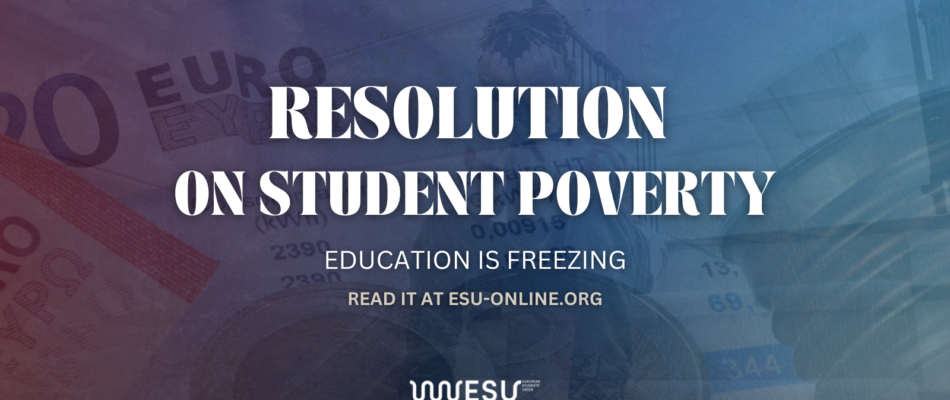
ESU Resolution on student poverty – ‘Education is freezing’
1. Introduction
Inflation rates of 10% have become the norm in Europe, with some countries reaching more than 20% price increases. Energy prices are booming, with increases of more than 40%. These figures and crises have not been seen or felt across Europe for decades. However, when discussing relief measures, students are again forgotten. When students voice their economic and social deprivations, they are usually unheard of or taken seriously. Yet student poverty, which has been growing in many European countries for years, is a bitter reality. The Covid 19 pandemic and the impact of Russia’s war on Ukraine have massively increased the risk of poverty and social exclusion among students. And yet, it seems that policymakers are simply ignoring students and the higher education sector when it comes to mitigating the impact of inflation on the population this coming winter, as well as forgetting about the specific impact the energy crisis has on students and higher education institutions.
Several documents and ratified treaties, such as the United Nations Declaration of Human Rights, the European Pillar of Social Rights and the Sustainable Development Goals, refer to the right of every human being to live in dignity. Furthermore, the Europe 2020 Strategy, which includes the target to eradicate poverty and social exclusion, even interlinks poverty and education since higher educational attainment generally decreases the risk of poverty. Despite this, students remain a societal group that is most often ignored regarding anti-poverty measures, even though they have the fundamental human right to live in dignity. Additionally, investments in their education reduce the future risk of poverty, benefiting society as a whole.
Poverty among students is as unacceptable as poverty in any other part of society and has broader effects on the community. In the face of the impact of the current crisis and the hardships that will follow due to the rising cost of living during the next winter months, we need effective and lasting measures against student poverty.
Against this backdrop, ESU launched the campaign “Education is freezing”, which aims to raise awareness about the issue of student poverty linked to the current two-fold inflation crises and the rise in energy costs. Through this resolution, student representatives across Europe call on specific measures to be adopted by relevant authorities, within their competencies, at European and national levels and higher education institutions.
2. Student poverty and the current crisis
Similar to the generally widening education gap, student poverty in Europe has been on the rise, with no significant actions taken by European and national policymakers alike to reverse this dangerous trend. In addition, another direction of underfunding the higher education sector has fed into the worsening of student living conditions.
Due to inflation and rising costs of living, students are facing the decision to choose between heating, eating, or dropping out of higher education altogether. In many student cities, it has become almost impossible to find affordable student accommodation due to the neglect regarding demographic changes and the need for investments in the housing market, generally and for student accommodation specifically, by public authorities. In some cities, the situation is so bad that higher education institutions and local public authorities advise students, especially international students, not to start their studies if they cannot obtain housing in time. Homelessness among students also exists, with students crashing on friends’ sofas or needing emergency/homeless shelters. But even those with accommodations fear being unable to pay the bills during the winter months due to rising energy prices and opt to freeze instead. Additionally, the rising food prices are affecting students’ consumer habits, with many resorting to buying low-quality products or making the conscious decision to simply eat less, posing a significant threat to students’ health. Food banks in student cities report a stark increase in students using their services. For students with disabilities and other health-related issues and students with children, additional problems occur regarding financing health services, medicine and care-related costs, especially in those countries where health and care services are not provided for free and in a satisfactory
Though many countries, if not all, do provide monetary and non-monetary aid to students, these aids are not sufficient anywhere. Neither the total nor maximum amount that can be received has been enough in years, nor have policymakers sufficiently adapted the aids to the rising costs, if not at all, due to the currently highly increasing inflation rates. Furthermore, in many countries, aid is based on parental income, making adult learners dependent on relatives, and aid is granted as loans, resulting in high students debts and therefore pushing the risk of poverty of young learners from the time of their studies simply towards the time after completing higher education. Additionally, due to their special status as full-time students, students usually cannot obtain any social security aid for persons in need nor for persons outside the workforce, not forgetting that, in many cases, international students in Europe do not have access to aid at all. All in all, students usually fall through the cracks of social safety systems.
This winter, the slogan of many students is “eating or heating”, with many more facing the realities of having to take on student debts or even pause or drop out of higher education. Unfortunately, all of this also affects student mental health and well-being, with the rates of depression among students at an all-time high.
Read the rest of the resolution here:
